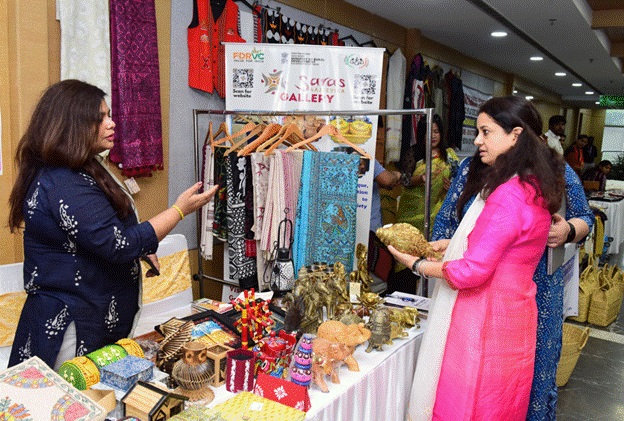No other Country in the World can pride itself as a Country of festivals as India does, and why not, when people of diverse religious beliefs co-exist peacefully. India, indeed, is a land of festivals and each one of them is celebrated with equal gaiety, be it Ganesh chaturdhi or Dussera or Divali of Hindus, Id of Muslims, Christmas of Christians and Guru Govind Singh’s birthday of Sikhs and so on. In the next a few paragraphs, In addition to festivals that are celebrated Country-wide (e.g Dussera, Divali, Id, Christmas, etc.), there are several other important region-specific events. I am only touching upon the positive aspects and not on negative/depressing sides such as pollution and some practices, since I respect every one’s freedom of expression of their belief and faith.
From August, festive season sets in the Country with Janmasthami, Varalakshmi vratam (a ladies festival in Andhra Pradesh), Rakhi and Ramzaan. They are followed by Ganesh Chaturdhi, Durgasthami (Dussera), both of ten days affairs, and Depavali, etc. Inflation or no inflation, all festivals are celebrated with pomp and show, money never seems to be an issue.
Crores of Rupees are spent in organsing each and every festival. Every one knows that entire year’s labour of Sivakasi fireworks’ industry goes into flames on Divali day! The Ganesh Chaturdhi and Durgasthami in September/October are other examples of the show of extravaganza – in terms of number of pandals that are put up through the Country, money spent, etc.
The Hyderabad media reported that some 40,000 idols of Lord Ganesh were
immersed on 10 and 11 last September at different places in the city, at the end of ten days Ganesh Chaturdhi (a major and important one in Maharashtra). One can imagine the cost involved in terms (i) of price tag of an idol – there seems to be a competition among organisers to outwit the other in terms of money spent on an idol (one of them was of 52’ feet height!), (ii) in decorating it even with precious/semi precious stones, (iii) on transportation of the same from the site of making to a pandal and then for immersion, (iv) erection of pandals, (v) of AnnaDHAn distribution, (vi) on sound system and so on. Similarly, several pandals were/will be erected in different parts of the city for Durgasthami. West Bengal, Delhi, and several others States see putting up of such pandals during this time.
Festivals, no doubt, are celebrated by one and all, though for a varied reasons. Devout look at them as occasion to offer specific prayers; while for ladies, it’s a time to show off their wealth: wearing best of sarees/dresses and exhibit their gold possession in the form ornaments. Many look to them as chance, can we say an excuse, to buy new dresses or products for home. Working sections of population and students, on the other hand, view them as a break from the routine. Working sections even try to combine festival holidays with week-end to pack of to some other place, even I did the same.
We often hear comments such as that the money spent in publicly observing a festival could have been better utilised. Even there are campaigns like “say no to crackers” during Divali. But, with due respect to these views, I submit that we tend to overlook an important aspect that such expenditures is helping some segments of the community in several ways. Despite my personal conviction against lavish spending, I still accept that it provides a galore of varied opportunities to quite a few sections of population.
These festive occasions offer diverse opportunities to different sections, depending upon how they look at them. Businessmen – small kirana and large shops – perceive them as an additional business opportunity. The local small kirana or grocery shops – in these days of organised retail trade gaining ground – meet the diverse requirements of the organisers of events. Small truck/tempo operators look forward for festivals so that they can make some additional income, taking advantage of the demand/supply gap. Similarly, tent houses, caterers, other small-time operators like cart/rickshaw pullers, etc eagerly wait for such events.
It is common to see large establishments – supplying diverse products and services – come up with so called “Bumper Offers” during these times, besides putting up of banners to advertise their products and offers at sites in the hope of garnering additional sales. One would find several other businesses such as auto dealers, real estate developers, tour operators, hospitality industry and so on extending concessions to attract customers during festive season, perhaps due increased tendency among the people to spend at such times.
For Youth clubs (several crop up during such occasions) in different colonies of a city, festivals offer a chance to demonstrate their organisational and leadership skills/qualities in organsing
an event. Here, I would like to emphasise an important feature of a publicly celebrating a festival and it relates to their ability to bring together people – synergy of energies. Such community merriment has yet another valuable contribution to the Society at large in the form of developing attachment and acquaintance among participants.
It’s also a chance for Youth Clubs to demonstrate their resourcefulness in inviting a VIP to the pandals, besides bringing people together. Politicians, big and local political workers look at them as an opportunity to renew their contacts with their respective vote-banks. Locals have become smart enough now to take advantage of the occasion to highlight their problems and needs to the visiting politician.
Electronic media, which are always concerned abut their TRP in the highly competitive world, compete with each other to get best coverage of VIPs’ visit to different pandals, bur ignore other aspects of celebrating a festivals.
Some significant dimensions of celebrations are, generally and unfortunately, overlooked by most, including Media. One, the ‘daily-wage earners’ see prospects of finding some work during these events, while the hawkers who put up shops at the important and largely visited pandals, more so at temples and places of worship, are able to make additional money .
Secondly, these occasions are eagerly looked forwarded by millions of street dwellers, a highly marginalised class. They consider publicly celebrating festival as a boon since it is an opportunity for them to have stomach full, at least for a few days in a year! Distribution of AnnaDHAN at the end of day’s puja is a customary. This demonstrates that ours, as said, is a Country of contrast: sections of population having sumptuous and special meals at festive time, while millions, on the other hand, struggling to have some thing to satiate their hunger.
Author Profile
Latest entries
Business22 February 2012Festivals, Entrepreneurs and MSMEs













